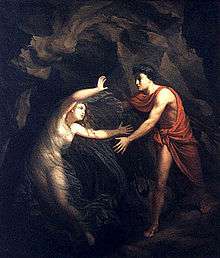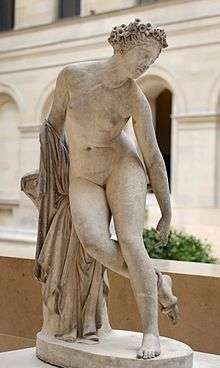Eurydice


In Greek mythology, Eurydice (/jʊˈrɪdɪsiː/; Greek: Εὐρυδίκη, Eurydikē) was an oak nymph or one of the daughters of Apollo (the god of music, prophecy, and light, who also drove the sun chariot, "adopting" the power as god of the Sun from the primordial god Helios). She was the wife of Orpheus, who tried to bring her back from the dead with his enchanting music.
Canonical story
Eurydice was the wife of Orpheus, who loved her dearly; on their wedding day, he played joyful songs as his bride danced through the meadow. One day, Aristaeus saw and pursued Eurydice, who stepped on a viper, was bitten, and died instantly. Distraught, Orpheus played and sang so mournfully that all the nymphs and deities wept and told him to travel to the Underworld to retrieve her, which he gladly did. After his music softened the hearts of Hades and Persephone, his singing so sweet that even the Erinyes wept, he was allowed to take her back to the world of the living. In another version, Orpheus played his lyre to put Cerberus, the guardian of Hades, to sleep, after which Eurydice was allowed to return with Orpheus to the world of the living. Either way, the condition was attached that he must walk in front of her and not look back until both had reached the upper world. Soon he began to doubt that she was there, and that Hades had deceived him. Just as he reached the portals of Hades and daylight, he turned around to gaze on her face, and because Eurydice had not yet crossed the threshold, she vanished back into the Underworld. When Orpheus later was killed by the Maenads at the orders of Dionysus, his soul ended up in the Underworld where he was reunited with Eurydice.
The story in this form belongs to the time of Virgil, who first introduces the name of Aristaeus and the tragic outcome.[1] Other ancient writers, however, speak of Orpheus's visit to the underworld in a more negative light; according to Phaedrus in Plato's Symposium,[2] the infernal deities only "presented an apparition" of Eurydice to him. Ovid says that Eurydice's death was not caused by fleeing from Aristaeus, but by dancing with naiads on her wedding day. In fact, Plato's representation of Orpheus is that of a coward; instead of choosing to die in order to be with the one he loved, he mocked the deities by trying to go to Hades to get her back alive. Since his love was not "true"—meaning he was not willing to die for it—he was punished by the deities, first by giving him only the apparition of his former wife in the underworld and then by being killed by women.[2]
The story of Eurydice may be a late addition to the Orpheus myths. In particular, the name Eurudike ("she whose justice extends widely") recalls cult-titles attached to Persephone. The myth may have been derived from another Orpheus legend in which he travels to Tartarus and charms the goddess Hecate.[3]
The story of Eurydice has a number of strong universal cultural parallels, from the Japanese myth of Izanagi and Izanami, the Mayan myth of Itzamna and Ixchel, the Indian myth of Savitri and Satyavan, to the Akkadian/Sumerian myth of Inanna's descent to the underworld. From the Bible, the story of Lot and his wife is also "often compared to the story of Orpheus and his wife Eurydike."[4]
Works of art
The story of Orpheus and Eurydice has been depicted in a number of works by artists, including Titian, Peter Paul Rubens, Nicolas Poussin, Corot[5] and recently, Bracha Ettinger whose series, Eurydice, was exhibited in the Pompidou Centre, (Face à l'Histoire, 1996); the Stedelijk Museum, Amsterdam (Kabinet, 1997) and The Royal Museum of Fine Arts, Antwerpen (Gorge(l), 2007). The story has inspired ample writings in the fields of ethics, aesthetics, art, and feminist theory.
In addition, the myth has been retold in operas by Jacopo Peri, Monteverdi, Gluck, Yevstigney Fomin, and Harrison Birtwistle (see List of Orphean operas). The myth is also the basis of Anais Mitchell's folk opera Hadestown. The story of Orpheus and Eurydice features prominently in the 1967 album Reflections by Manos Hadjidakis, and the Nick Cave and the Bad Seeds album The Lyre of Orpheus.
Additionally, the story of Orpheus and Eurydice is the basis of a play by Sarah Ruhl. It inspired the 1959 film Black Orpheus by Marcel Camus. The myth also inspired the American playwright Tennessee Williams' 1957 drama Orpheus Descending.
Other uses include:
- Valsa de Euridice, a song by Vinicius de Moraes
- Euridice, an opera by Jacopo Peri (1600), the first genuine opera whose music survives to this day[6]
- Orphée, directed by Jean Cocteau (1949)
- Orfeo ed Euridice, an opera by Christoph Willibald Gluck
- Eurydice, a play by Sarah Ruhl
- Orfeu Negro, a 1959 adaptation of the classic myth, filmed in Brazil
- L'Orfeo, by Claudio Monteverdi (1607), widely regarded as the first operatic masterwork[7]
- (Love is) Myth or Madness from the eponymous album, Passerine, a Sarasota-based folk group
- The Lyre of Orpheus, an album by Nick Cave and the Bad Seeds
- Orpheus, a song by Manos Hadjidakis and The New York Rock and Roll Ensemble
- Eurydice, a section of Écho d'Orphée, Pour Pierre Schaeffer composed by Pierre Henry.
- Eurydice, a play by Jean Anouilh
- Euridice, a song from the album Focus II (Moving Waves) by Focus
- Evrydiki BA 2O37, 1975 film directed by Nikos Nikolaidis.
- Eurydice, a song from the album Echoes and Artifacts by The Crüxshadows (2001)
- Eurydice, a song from the album The Dawnseeker by Sleepthief (2006)
- The Eurydice Project, written by D.J. Whistler (2007)
- Hadestown, an 2010 ensemble album by Anais Mitchell, featuring Mitchell as Eurydice, Justin Vernon as Orpheus and Ani DiFranco among others, retelling the myth as a 'folk opera' in a post-apocalyptic Depression era America.
- Eurydice by Wayne Shorter and recorded by Weather Report on their 1971 album, Weather Report.
- Orpheus and Eurydice: A Myth Underground, theatre production written by Molly Davies with music by James Johnston, Nick Cave and the Bad Seeds for the National Youth Theatre at the Old Vic Tunnels, directed by James Dacre (2011)
- Tampa based indoor percussion group Attack Percussion presented their show "eurydice" for competition in 2012
- Awful Sound (Oh Eurydice) and It's Never Over (Oh Orpheus) songs from the album Reflektor by Arcade Fire (2013)
- Eurydice from the album Days of Abandon by The Pains of Being Pure at Heart (2014)
- Eurydice was the name of a female alien in the Delta Quadrant that Captain James T. Kirk and the USS Enterprise crew encounter in Star Trek #43.
Honours
- Eurydice Peninsula in Antarctica is named after Eurydice.
References
- ↑ M. Owen Lee, Virgil as Orpheus: A Study of the Georgics, State University of New York Press, Albany (1996), p. 9.
- 1 2 Symposium 179d-e.
- ↑ Robert Graves, The Greek Myths, Penguin Books Ltd., London (1955), Volume 1, Chapter 28, "Orpheus", p. 115.
- ↑ Mathew Clark, Exploring Greek Myths, Blackwell Publishing, Chichester (2012), Chapter 8, "The Judgment of Paris", p. 106.
- ↑ "Orpheus Leading Eurydice from the Underworld" 1861, painting at the MFAH in Houston by Jean-Baptiste-Camille Corot.
- ↑ Rosand, "Opera: III. Early opera, 1600–90"
- ↑ Whenham (1986) p. xi
Sources
- Ovid, Metamorphoses 10
- The Library 1.3.2
- Pausanias, Description of Greece 9.30
- Virgil, Georgics 4.453
- Plato, Symposium
- Sleepthief, "Eurydice" featuring Jody Quine"
- Griselda Pollock, "Abandoned at the Mouth of Hell". In: Looking Back to the Future. G&B Arts. ISBN 90-5701-132-8.
- Judith Butler, "Bracha's Eurydice". In: Bracha Lichtenberg Ettinger: Eurydice Series. Edited by Catherine de Zegher and Brian Massumi. Drawing Papers n.24. The Drawing center, NY, 2001. Reprinted in: Theory, Culture and Society, 21(1), 2004. ISSN 0263-2764.
- Emmanuel Levinas in conversation with Bracha L. Ettinger, "What would Eurydice Say?" (1991–1993). Reprinted in 1997. Reprinted in Athena: Philosophical Studies, Volume 2, 2006. ISSN 1822-5047.
- Dorota Glowaka, "Lyotard and Eurydice". In: Margret Grebowicz (ed.), Gender after Lyotard. NY: Suny Press, 2007. ISBN 978-0-7914-6956-9
- Christine Buci-Glucksmann, "Eurydice and her Doubles. Painting after Auschwitz", in: Artworking 1985-1999, Amsterdam: Ludion, 2000. ISBN 90-5544-283-6.
- Carol Ann Duffy, "Eurydice". In: The World's Wife. ISBN 978-0-330-37222-0.
- Ellen Rosand, "Opera: III. Early opera, 1600–90", Grove Music Online, ed. L. Macy (accessed via subscription 27 April 2010)
- John Whenham, Claudio Monteverdi, Orfeo, Cambridge University Press, 1986. ISBN 0-521-28477-5
- The 2013 Arcade Fire album Reflektor is partially based on the myth of Orpheus and Euridice (most notably the tracks "Awful Sound (Oh Eurydice)" and "It's Never Over (Oh Orpheus)".
Further reading
- Griselda Pollock. "Orphée et Eurydice: le temps/l'éspace/le regard traumatique". In: Julia Kristeva et al., eds. Guerre et paix des sexes. Hachette, 2009.
- Jennie Hirsh, and Isabelle D. Wallace, eds. Contemporary Art and Classical Myth. Farnham: Ashgate, 2011. ISBN 978-0-7546-6974-6.
- Irene Masing-Delic, "Replication or Recreation? The Eurydice Motif in Nabokov's Russian Oeuvre", Russian Literature, 70.3 (2011), 391–414.
External links
![]() Media related to Eurydice at Wikimedia Commons
Media related to Eurydice at Wikimedia Commons